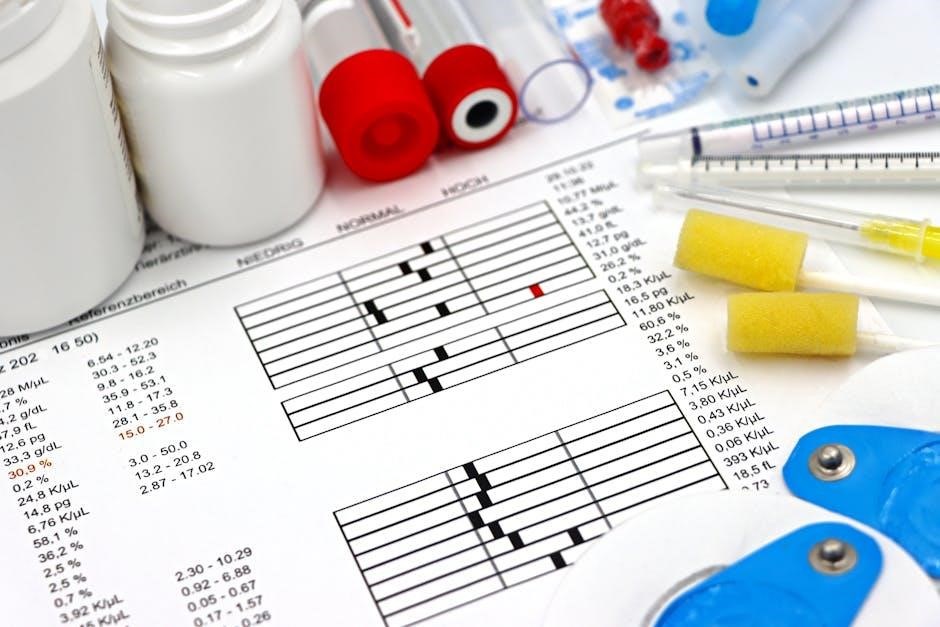
Welcome to Ackley and Ladwig’s Nursing Diagnosis Handbook, 13th Edition. This guide provides a comprehensive overview of nursing diagnosis, emphasizing evidence-based practice to enhance patient care outcomes.
1.1 Overview of the Handbook
Ackley and Ladwig’s Nursing Diagnosis Handbook, 13th Edition, serves as a comprehensive resource for nurses, offering detailed guidance on formulating accurate diagnoses. It provides evidence-based information, practical applications, and updated content to support clinical decision-making. The handbook emphasizes a user-friendly approach, helping nurses identify diagnoses, develop care plans, and document outcomes effectively. With case studies and a glossary, it remains an indispensable tool for both students and practicing professionals in delivering high-quality patient care.
1.2 Importance of Nursing Diagnosis in Practice
Nursing diagnosis is fundamental to effective patient care, enabling nurses to identify health issues, prioritize interventions, and evaluate outcomes. It promotes patient-centered care by addressing specific needs and risks. A standardized language for diagnoses enhances communication among healthcare teams, ensuring coordinated and evidence-based interventions. Accurate nursing diagnoses are essential for developing individualized care plans, improving patient outcomes, and maintaining high-quality care across diverse clinical settings.
1.3 Brief History of the Handbook
Ackley and Ladwig’s Nursing Diagnosis Handbook was first published in 1996, aiming to provide a standardized guide for nursing diagnoses. Over the years, it has evolved to reflect evidence-based practices and emerging healthcare needs. Each edition incorporates new research, updated taxonomy, and clinical expertise, making it a trusted resource for nurses worldwide. The 13th edition continues this legacy, offering a comprehensive tool for accurate diagnosis and effective patient care.

Key Features of the 13th Edition
The 13th edition introduces new nursing diagnoses, updated taxonomy, and enhanced evidence-based content, ensuring accurate and effective care planning for diverse patient populations.
2.1 New Additions and Updates
The 13th edition includes new nursing diagnoses, revised definitions, and updated taxonomy based on NANDA-I standards. It incorporates contemporary clinical knowledge, addressing emerging health issues and care priorities. Enhanced diagnostic criteria and etiologies provide clarity, while new care plans and interventions support evidence-based decision-making. Additional resources, such as documentation templates, aid in streamlining patient assessment and outcome tracking, ensuring comprehensive and effective care delivery across diverse clinical settings.
2.2 Enhanced Organization and Structure
The 13th edition features a streamlined layout with standardized headings and bullet points for easy navigation. Content is logically organized by diagnosis, with clear definitions, related factors, and evidence-based interventions. The revised structure aligns with current nursing standards, making it simpler for practitioners to locate information quickly. This user-friendly design enhances accessibility, ensuring nurses can efficiently apply the guide in clinical settings to improve patient care outcomes.
2.3 Integration of Evidence-Based Practice
The 13th edition seamlessly integrates evidence-based practice, ensuring diagnoses and interventions are grounded in current research. Each entry includes updated references and clinical guidelines, reflecting the latest advancements in nursing care. This emphasis on evidence-based practice helps nurses make informed decisions, improve patient outcomes, and align with professional standards. The handbook serves as a reliable resource for translating research into actionable, patient-centered care strategies.

Understanding Nursing Diagnosis
Nursing diagnosis is the process of identifying health issues based on patient data, guiding individualized care plans to improve patient outcomes and quality of life.
3.1 Definition and Purpose
Nursing diagnosis is a clinical judgment process that identifies health problems, risk factors, or actual or potential conditions that require nursing interventions. Its purpose is to guide the development of individualized care plans, improving patient outcomes and quality of life. This patient-centered approach focuses on addressing physical, emotional, and social needs, ensuring holistic care. The process is structured around the NANDA-I taxonomy, providing a standardized framework for diagnosis and intervention.
3.2 The Nursing Process and Its Phases
The nursing process is a systematic, patient-centered method of care that includes assessment, diagnosis, planning, implementation, and evaluation. Assessment gathers data about the patient’s health status; Diagnosis identifies actual or potential health problems. Planning sets goals and outcomes. Implementation carries out interventions, while evaluation assesses the effectiveness of care. This cyclical process ensures continuous improvement and personalized care, aligning with evidence-based practices to enhance patient outcomes and satisfaction.
3.3 Role of NANDA-I Taxonomy
NANDA-I Taxonomy provides a standardized framework for nursing diagnoses, facilitating clear communication among healthcare professionals. It organizes diagnostic knowledge into domains, classes, and concepts, ensuring consistency in documentation and care planning. This taxonomy supports evidence-based practice by categorizing diagnoses, making it easier to identify patterns and prioritize interventions. The handbook aligns with NANDA-I standards, enabling nurses to apply diagnoses accurately and effectively in clinical settings, enhancing patient outcomes and care quality.

How to Use the Handbook Effectively
This section guides you on effectively utilizing Ackley and Ladwig’s Nursing Diagnosis Handbook. Discover how to navigate its comprehensive resources, apply evidence-based insights, and implement practical care strategies;
4.1 Identifying Appropriate Diagnoses
Identifying appropriate diagnoses involves assessing patient data, defining characteristics, and risk factors. Use the handbook to guide your understanding of NANDA-I approved diagnoses. Prioritize diagnoses based on patient-specific needs, ensuring they align with clinical presentation and care goals. This step lays the foundation for effective care planning and intervention. Always validate diagnoses with evidence and patient input to ensure accuracy and relevance.
- Assess defining characteristics and risk factors.
- Prioritize diagnoses based on patient needs.
- Validate with evidence and patient input.
4.2 Developing Individualized Care Plans
Developing individualized care plans involves setting specific, measurable goals based on identified diagnoses. Use the handbook to outline interventions, expected outcomes, and evaluation criteria. Tailor plans to patient preferences, strengths, and limitations. Ensure collaboration with the patient and healthcare team to promote adherence and effectiveness. Regularly update plans to reflect progress or changing needs, documenting outcomes for continuous improvement.
- Set SMART goals aligned with diagnoses.
- Outline interventions and expected outcomes.
- Tailor plans to patient needs and preferences.
- Document and evaluate progress regularly.
4.3 Documenting and Evaluating Outcomes
Accurate documentation and evaluation of patient outcomes are critical for effective care. Use the handbook to guide clear, concise documentation of patient responses to interventions. Regularly assess whether goals are met and adjust care plans accordingly. Documenting outcomes ensures accountability, informs future care decisions, and demonstrates the effectiveness of nursing interventions. Use standardized language and tools provided in the handbook to maintain consistency and clarity in documentation.
- Use clear, concise language in documentation.
- Regularly assess goal achievement.
- Adjust care plans based on outcomes.
- Ensure accountability and informed decision-making.

Common Nursing Diagnoses
This section presents common nursing diagnoses encountered in clinical practice. Ackley and Ladwig’s handbook categorizes these diagnoses, providing clear definitions and guidelines for effective care planning.
5.1 Activity Intolerance
Activity Intolerance refers to a patient’s inability to perform daily activities due to fatigue or insufficient energy. This diagnosis is common in individuals with chronic illnesses, cardiovascular conditions, or prolonged immobility. Nurses assess for signs such as shortness of breath, lethargy, or decreased endurance. Interventions focus on pacing activities, promoting rest periods, and improving physical conditioning. The handbook provides evidence-based strategies to help patients gradually increase their activity levels and enhance overall well-being.
5.2 Pain Management
Pain Management focuses on assessing and alleviating acute or chronic pain to improve patient comfort and quality of life. Nurses use standardized pain assessment tools, such as the 0-10 pain scale, to evaluate intensity and characteristics. Interventions include pharmacological therapies, non-pharmacological strategies like relaxation techniques, and lifestyle modifications. The handbook emphasizes evidence-based approaches to tailor pain management plans, ensuring safe and effective care while addressing the patient’s physical and emotional needs.
5.3 Anxiety and Stress Disorders
Anxiety and stress disorders are common conditions that require tailored nursing interventions. Nurses assess patients for signs like restlessness, difficulty concentrating, and heightened tension. Interventions may include relaxation techniques, cognitive-behavioral strategies, and medication management. The handbook provides evidence-based guidelines to help nurses develop care plans that address both acute and chronic anxiety, promoting emotional well-being and resilience in patients across various clinical settings.
Special Considerations in Nursing Diagnosis
Special considerations in nursing diagnosis require nurses to adapt care plans to diverse patient needs, ensuring culturally competent, age-appropriate, mentally sensitive interventions in complex settings.
6.1 Cultural Competence in Care
Cultural competence is essential in nursing, ensuring care respects diverse patient beliefs, values, and practices. The handbook emphasizes assessing cultural influences on health behaviors and outcomes, guiding nurses to provide individualized, sensitive care. It offers strategies to integrate cultural knowledge into diagnosis and planning, promoting trust and better health outcomes. Nurses are encouraged to self-reflect on biases and adapt care to meet unique needs, fostering a person-centered approach.
6.2 Pediatric and Geriatric Populations
Nursing care for pediatric and geriatric populations requires tailored approaches due to their unique physiological and developmental needs. The handbook provides age-specific assessments and interventions, addressing challenges like communication barriers in children and age-related health declines in the elderly. It emphasizes the importance of family involvement and caregiver support, offering strategies to adapt care plans for these vulnerable groups. This ensures holistic, age-appropriate nursing diagnoses and interventions.
6.3 Mental Health and Psychiatric Nursing
The handbook addresses mental health and psychiatric nursing with a focus on evidence-based diagnoses and interventions. It covers common conditions like anxiety, depression, and psychosis, providing tailored care strategies. Emphasis is placed on therapeutic communication, patient-centered approaches, and collaboration with interdisciplinary teams. The guide also highlights the importance of promoting mental health literacy and reducing stigma, ensuring comprehensive care for patients with psychiatric and mental health needs.

Legal and Ethical Issues
Nursing practice requires adherence to legal standards and ethical principles, ensuring patient rights and safety while balancing professional responsibilities and moral obligations in care delivery.
7.1 Accountability in Nursing Practice
Accountability in nursing practice involves being responsible for one’s actions, decisions, and outcomes. Nurses must adhere to professional standards, policies, and legal requirements. Accurate documentation and ethical decision-making are critical. Accountability ensures patient safety, maintains trust, and upholds the integrity of the nursing profession. It also involves recognizing and addressing errors promptly to prevent harm and improve care quality. Nurses are legally and morally accountable for their practice, reflecting their commitment to patient-centered care and professional excellence.
7.2 Ethical Dilemmas in Diagnosis and Care
Ethical dilemmas in nursing arise when conflicting values or principles guide decision-making. Common issues include patient autonomy versus beneficence, truth-telling, and resource allocation. Cultural and religious beliefs often influence these challenges. Nurses must use ethical frameworks to navigate such situations, ensuring care aligns with patient rights and professional standards. Effective communication and collaboration with the healthcare team are essential to resolve dilemmas while maintaining patient trust and dignity;
7.3 Informed Consent and Patient Rights
Informed consent ensures patients are fully aware of their care options, risks, and benefits, enabling autonomous decision-making. Respecting patient rights, including confidentiality, dignity, and the right to refuse treatment, is paramount. Nurses play a crucial role in upholding these principles, ensuring ethical and legal standards are met. Clear communication and documentation are essential to validate the consent process and protect patient autonomy throughout care delivery.

Case Studies and Practical Applications
Case studies provide real-world examples, bridging theory and practice. They enhance critical thinking and decision-making skills, offering practical insights into nursing diagnoses and care planning strategies effectively.
8.1 Real-World Scenarios
Real-world scenarios in the handbook present practical examples of nursing diagnoses in diverse clinical settings. These scenarios help nurses apply theoretical knowledge to actual patient situations, enhancing their ability to identify and address specific health concerns. By exploring realistic case examples, nurses can develop critical thinking and decision-making skills, ensuring effective and individualized care plans. These scenarios cover a wide range of conditions, from acute care to community health, making them invaluable for both students and practicing professionals.
8.2 Applying the Handbook in Clinical Settings
The handbook serves as a practical tool for nurses in clinical environments, offering clear guidelines for assessing patients and formulating accurate diagnoses. By applying the handbook’s evidence-based approaches, nurses can develop targeted care plans that address specific patient needs. Its structured format aids in prioritizing interventions, documenting progress, and evaluating outcomes effectively. This ensures consistent, high-quality care delivery across various healthcare settings, making it an indispensable resource for daily practice.
8;3 Lessons Learned from Case Studies
The handbook’s case studies provide real-world insights, highlighting best practices and common challenges in nursing diagnosis. These scenarios emphasize the importance of critical thinking and evidence-based interventions. By analyzing patient outcomes, nurses can refine their assessment skills and develop more effective care plans. The lessons learned from these case studies enhance clinical decision-making and improve the quality of patient care in diverse healthcare settings.

Technology and Nursing Diagnosis
Technology enhances nursing diagnosis accuracy and efficiency through tools like EHRs and telehealth. This edition explores technology’s integration with evidence-based practice, offering innovative solutions for nurses to improve patient outcomes effectively and adapt to the evolving healthcare landscape.
9.1 Electronic Health Records (EHRs)
EHRs streamline nursing diagnosis by providing standardized documentation and real-time access to patient data. They enhance care coordination, reduce errors, and improve patient safety. The 13th edition highlights how EHRs integrate with evidence-based practice, offering nurses efficient tools for documenting assessments, diagnoses, and outcomes. This digital advancement supports informed decision-making and continuity of care, aligning with the handbook’s focus on modern, effective nursing practices.
9.2 Nursing Informatics and Diagnosis
Nursing informatics bridges technology and clinical practice, enhancing diagnostic accuracy and care delivery. The handbook explores how informatics tools, such as decision-support systems, integrate with nursing diagnoses to improve patient outcomes. By leveraging standardized terminologies like NANDA-I, informatics supports evidence-based practice, enabling nurses to document and manage diagnoses more efficiently. This fusion of technology and nursing expertise fosters precision, collaboration, and better-informed care decisions in dynamic healthcare environments.
9.3 Future Trends in Digital Nursing Tools
Future trends in digital nursing tools include advanced AI integration, real-time data analytics, and mobile health applications. These innovations will enhance diagnostic precision, streamline workflows, and improve patient monitoring. Predictive analytics will enable early detection of health issues, while telehealth platforms will expand access to care. Interoperability with EHRs will ensure seamless data sharing, fostering a more connected and efficient healthcare system. These advancements promise to revolutionize nursing practice and patient outcomes.
Ackley and Ladwig’s Nursing Diagnosis Handbook remains a vital resource for nurses, guiding evidence-based practice. Future editions will likely incorporate emerging technologies and care innovations.
10.1 Summary of Key Points
Ackley and Ladwig’s Nursing Diagnosis Handbook, 13th Edition, offers a comprehensive guide to nursing diagnosis, emphasizing evidence-based practice and updated care planning strategies. It provides detailed diagnoses, interventions, and outcomes, aiding nurses in delivering personalized patient care. The handbook’s enhanced structure and new additions ensure clarity and relevance, making it an indispensable resource for both students and professionals. Its focus on evolving healthcare needs ensures continued relevance in future practice.
10.2 The Evolving Role of Nursing Diagnosis
Nursing diagnosis continues to evolve, driven by advancements in technology, evidence-based practice, and the increasing complexity of patient care. The 13th Edition reflects these changes, emphasizing personalized care and interdisciplinary collaboration. As healthcare demands grow, nursing diagnosis plays a pivotal role in improving patient outcomes. Future trends, such as AI integration and digital tools, will further enhance the precision and efficiency of nursing diagnoses, shaping the profession’s future.
10.3 Recommendations for Future Editions
Future editions should expand on emerging trends, such as telehealth and AI-driven diagnostics. Additional case studies and enhanced digital tools would enrich learning. Including more diverse, culturally sensitive scenarios and advanced care planning templates could further support nurses. Expanding the glossary and indexing system would improve accessibility. Regular updates to reflect new research and clinical guidelines will ensure the handbook remains a vital resource for nursing professionals worldwide.

References and Further Reading
This section provides a comprehensive list of references and suggests additional resources, including journals and websites, for further reading on nursing diagnosis and care planning.
11.1 Bibliography of the Handbook
The bibliography provides a comprehensive list of references cited throughout the handbook, including academic journals, books, and evidence-based practice guidelines. Each entry is formatted according to APA style, ensuring clarity and academic integrity. This section serves as a valuable resource for nurses seeking to explore topics in greater depth or conduct further research in nursing diagnosis and care planning.
11.2 Additional Resources for Nursing Diagnosis
Supplement your learning with additional resources such as NANDA-I guidelines, nursing journals, and online databases. Explore evidence-based practice websites, professional nursing organizations, and educational platforms offering continuing education courses. These resources provide updated information, clinical tools, and research to enhance your understanding and application of nursing diagnosis in diverse clinical settings.

Appendix
The appendix provides supplementary materials, including a glossary of key terms and an index of nursing diagnoses, to support effective use of the handbook.
12.1 Glossary of Terms
The glossary provides clear definitions of key terms and concepts related to nursing diagnosis, ensuring clarity and consistency in understanding. It covers essential terminology, such as NANDA-I diagnoses, NIC interventions, and NOC outcomes, to support accurate clinical decision-making. This resource is invaluable for students, educators, and practitioners seeking to refine their knowledge of nursing diagnosis and its application in practice.
12.2 Index of Diagnoses
The Index of Diagnoses serves as a quick reference guide, allowing users to locate specific nursing diagnoses efficiently. Organized alphabetically, it includes all diagnoses covered in the handbook, with cross-references to relevant sections. This feature enhances navigation, saving time for practitioners and students. It ensures easy access to detailed information, promoting accurate and effective care planning. The index is an indispensable tool for rapid retrieval of diagnostic content.